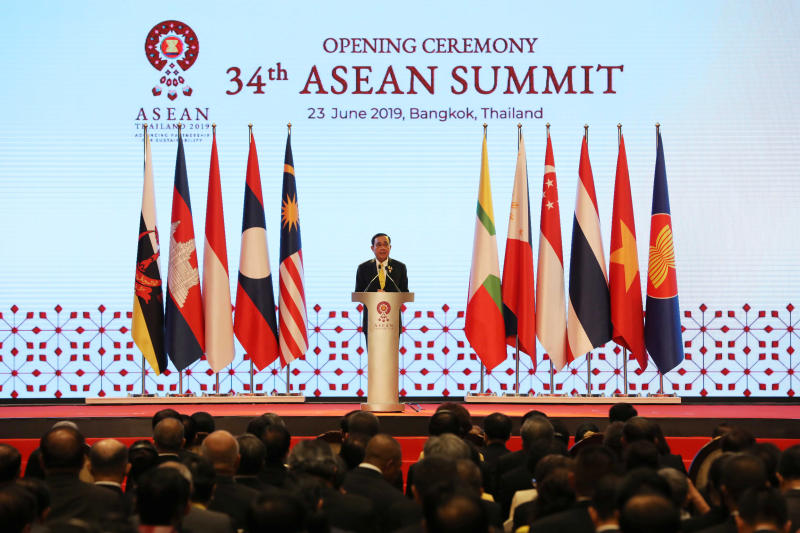News analysis
What comes after Asean's Indo-Pacific vision is more crucial, say analysts
Sign up now: Get insights on Asia's fast-moving developments

Thai PM Prayut Chan-o-cha speaking at the opening ceremony of the 34th Asean Summit in Bangkok on June 23, 2019.
PHOTO: REUTERS
Follow topic:
BANGKOK - China's increasingly tense face-off with the United States risks sidelining Asean, which must reclaim its voice.
That was the premise which gave rise to the "Asean Outlook on the Indo Pacific", a document that lays out its 10-member nations' common position on regional cooperation, security and prosperity.
The five-page document released on Sunday (June 23) marks the first attempt by Asean to articulate a joint perspective of a contested discourse. But, with much of the material culled from previous Asean announcements, there are few substantive statements, say analysts.
The document broadly outlines Asean's vision to improve connectivity, hasten maritime cooperation and guide development by following long-espoused principles like rule of law and renunciation of the threat or use of force.
It neither mentions the US nor China by name, and tiptoes around the contentious South China Sea dispute by referring to "unresolved maritime disputes" and "unsustainable exploitation of maritime resources and maritime pollution" to say: "There is a need to prevent, manage and eventually resolve these issues in a more focused, peaceful and comprehensive way."
It observes that "the rise of material powers, i.e. economic and military, requires avoiding the deepening of mistrust, miscalculation, and patterns of behavior based on a zero-sum game."
Asean's vision is fundamentally different from Washington's Indo-Pacific strategy, notes Mr Aaron Connelly, a fellow at the International Institute for Strategic Studies.
"The US Indo-Pacific Strategy report that came out on June 1 very clearly identifies the problem as Chinese actions, particularly Chinese coercion of South-east Asian countries. This (Asean) document appears to regard the problem... as US-China rivalry," he told The Straits Times.
Work on Asean's framework was initiated last year, at around the same time the US was drumming up support for its "Free and Open Indo-Pacific" initiative.
Viewed by some as an extension of the long-standing American policy, the US vision involves roping in allies across the Indian and Pacific oceans to maintain a rules-based international order, as well as mobilising both private and public funding to develop regional infrastructure.
Also rapidly gaining traction in the region is China's Belt and Road Initiative, which links economies from as far as Africa and Europe through projects that also serve as a conduit for Beijing's influence.
The competing big-power visions put Asean - which makes decisions by consensus - at a crossroads.
"Asean has to contemplate its future as a South-east Asian-centric entity in response to pressures toward a wider and more inclusive form of regionalism," says Dr Tang Siew Mun, the head of Iseas-Yusof Ishak Institute's Asean Studies Centre.
"Fundamentally, the (other) Indo-Pacific proposals stem from the view that Asean is indifferent or incapable of responding to new strategic developments, and Asean has to come up from a credible response beyond issuing an Outlook," adds Dr Tang.
As a vision statement, Asean Outlook does not address the fundamental problems, argues Mr Connelly.
"Instead of dealing with the strategic rivalry that has emerged, it... basically wishes it away."
Individual Asean countries, he said, have already crafted divergent strategies for managing the US-China rivalry. "Nothing in this (Asean Outlook) is likely to change that, or to bridge those divergent strategies," he said.
On the one hand, any new regional architecture would find it hard to succeed without involving Asean, say analysts. On the other, Asean will further lose credibility if it cannot turn vision to action.
"After decades of singing the tune of (Asean) Centrality, it now falls on Asean to defend this assertion," says Dr Tang.

